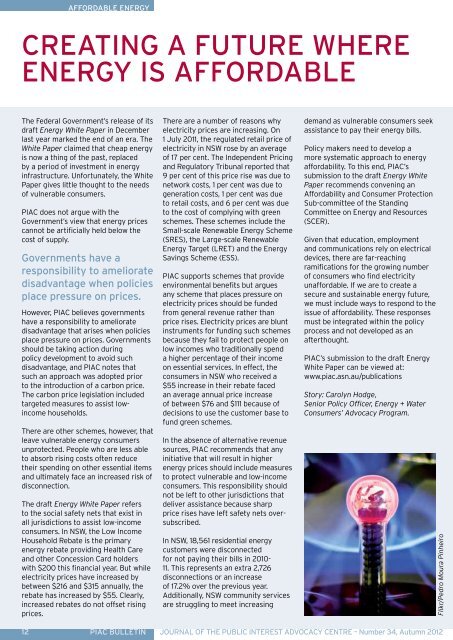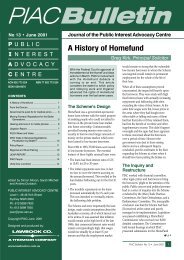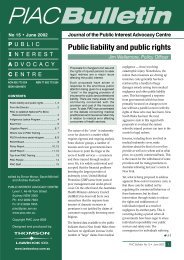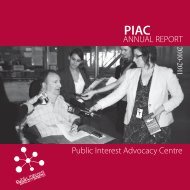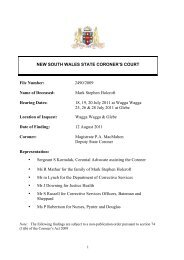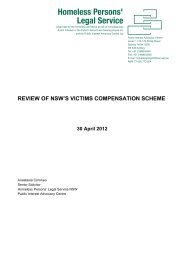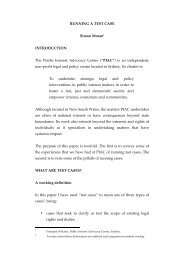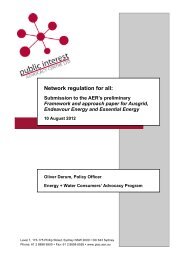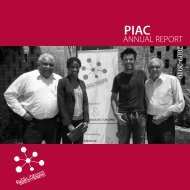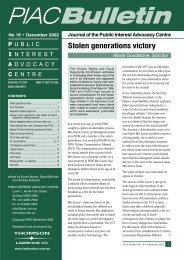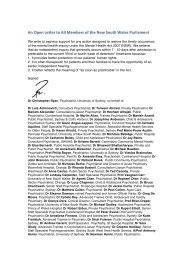PIAC Bulletin - Public Interest Advocacy Centre
PIAC Bulletin - Public Interest Advocacy Centre
PIAC Bulletin - Public Interest Advocacy Centre
Create successful ePaper yourself
Turn your PDF publications into a flip-book with our unique Google optimized e-Paper software.
AFFORDABLE ENERGY<br />
Creating a future where<br />
energy is affordable<br />
The Federal Government’s release of its<br />
draft Energy White Paper in December<br />
last year marked the end of an era. The<br />
White Paper claimed that cheap energy<br />
is now a thing of the past, replaced<br />
by a period of investment in energy<br />
infrastructure. Unfortunately, the White<br />
Paper gives little thought to the needs<br />
of vulnerable consumers.<br />
<strong>PIAC</strong> does not argue with the<br />
Government’s view that energy prices<br />
cannot be artificially held below the<br />
cost of supply.<br />
Governments have a<br />
responsibility to ameliorate<br />
disadvantage when policies<br />
place pressure on prices.<br />
However, <strong>PIAC</strong> believes governments<br />
have a responsibility to ameliorate<br />
disadvantage that arises when policies<br />
place pressure on prices. Governments<br />
should be taking action during<br />
policy development to avoid such<br />
disadvantage, and <strong>PIAC</strong> notes that<br />
such an approach was adopted prior<br />
to the introduction of a carbon price.<br />
The carbon price legislation included<br />
targeted measures to assist lowincome<br />
households.<br />
There are other schemes, however, that<br />
leave vulnerable energy consumers<br />
unprotected. People who are less able<br />
to absorb rising costs often reduce<br />
their spending on other essential items<br />
and ultimately face an increased risk of<br />
disconnection.<br />
The draft Energy White Paper refers<br />
to the social safety nets that exist in<br />
all jurisdictions to assist low-income<br />
consumers. In NSW, the Low Income<br />
Household Rebate is the primary<br />
energy rebate providing Health Care<br />
and other Concession Card holders<br />
with $200 this financial year. But while<br />
electricity prices have increased by<br />
between $216 and $315 annually, the<br />
rebate has increased by $55. Clearly,<br />
increased rebates do not offset rising<br />
prices.<br />
There are a number of reasons why<br />
electricity prices are increasing. On<br />
1 July 2011, the regulated retail price of<br />
electricity in NSW rose by an average<br />
of 17 per cent. The Independent Pricing<br />
and Regulatory Tribunal reported that<br />
9 per cent of this price rise was due to<br />
network costs, 1 per cent was due to<br />
generation costs, 1 per cent was due<br />
to retail costs, and 6 per cent was due<br />
to the cost of complying with green<br />
schemes. These schemes include the<br />
Small-scale Renewable Energy Scheme<br />
(SRES), the Large-scale Renewable<br />
Energy Target (LRET) and the Energy<br />
Savings Scheme (ESS).<br />
<strong>PIAC</strong> supports schemes that provide<br />
environmental benefits but argues<br />
any scheme that places pressure on<br />
electricity prices should be funded<br />
from general revenue rather than<br />
price rises. Electricity prices are blunt<br />
instruments for funding such schemes<br />
because they fail to protect people on<br />
low incomes who traditionally spend<br />
a higher percentage of their income<br />
on essential services. In effect, the<br />
consumers in NSW who received a<br />
$55 increase in their rebate faced<br />
an average annual price increase<br />
of between $76 and $111 because of<br />
decisions to use the customer base to<br />
fund green schemes.<br />
In the absence of alternative revenue<br />
sources, <strong>PIAC</strong> recommends that any<br />
initiative that will result in higher<br />
energy prices should include measures<br />
to protect vulnerable and low-income<br />
consumers. This responsibility should<br />
not be left to other jurisdictions that<br />
deliver assistance because sharp<br />
price rises have left safety nets oversubscribed.<br />
In NSW, 18,561 residential energy<br />
customers were disconnected<br />
for not paying their bills in 2010-<br />
11. This represents an extra 2,726<br />
disconnections or an increase<br />
of 17.2% over the previous year.<br />
Additionally, NSW community services<br />
are struggling to meet increasing<br />
demand as vulnerable consumers seek<br />
assistance to pay their energy bills.<br />
Policy makers need to develop a<br />
more systematic approach to energy<br />
affordability. To this end, <strong>PIAC</strong>’s<br />
submission to the draft Energy White<br />
Paper recommends convening an<br />
Affordability and Consumer Protection<br />
Sub-committee of the Standing<br />
Committee on Energy and Resources<br />
(SCER).<br />
Given that education, employment<br />
and communications rely on electrical<br />
devices, there are far-reaching<br />
ramifications for the growing number<br />
of consumers who find electricity<br />
unaffordable. If we are to create a<br />
secure and sustainable energy future,<br />
we must include ways to respond to the<br />
issue of affordability. These responses<br />
must be integrated within the policy<br />
process and not developed as an<br />
afterthought.<br />
<strong>PIAC</strong>’s submission to the draft Energy<br />
White Paper can be viewed at:<br />
www.piac.asn.au/publications<br />
Story: Carolyn Hodge,<br />
Senior Policy Officer, Energy + Water<br />
Consumers’ <strong>Advocacy</strong> Program.<br />
Flikr/Pedro Moura Pinheiro<br />
12 <strong>PIAC</strong> BULLETIN JOURNAL OF THE PUBLIC INTEREST ADVOCACY CENTRE – Number 34, Autumn 2012


